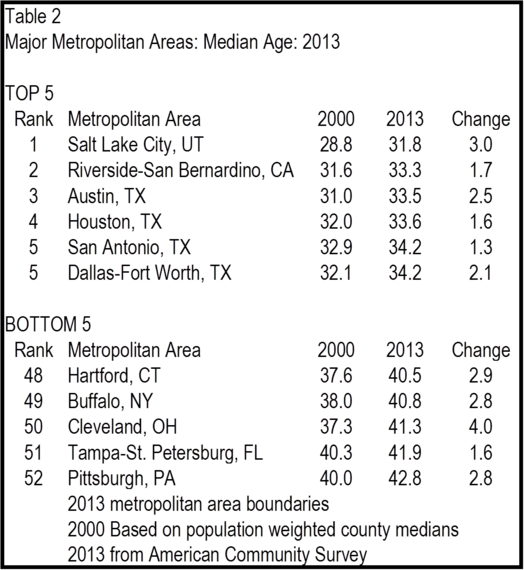America is getting older, as medical science prolongs life expectancy and the fertility rate hovers at or even below the replacement rate. One metric for gauging the nation's aging is the median age - the age at which one half the population is younger and the other half is older. In 2000, the median age in the United States was 35.3. By 2013, the median age had increased to 37.5.
But the nation's aging is by no means uniform. Each of the nation's 52 major metropolitan areas (over 1 million population), got older between 2000 and 2013. However, the difference was substantial, from a relatively small 0.4 years to a more than 10 times larger 4.6 years.
Metropolitan Areas Aging the Least
Nine of the 10 metropolitan areas that have aged the least attracted more residents from other parts of the country than they lost between 2000 and 2013 (net domestic migration data from the Census Bureau annual population estimates). This is consistent with data showing that younger households move more. The Current Population Survey reports indicates that households with householders less than 35 years of age are more than 2.5 times as likely to move between states as those led by householders from 35 to 64. The real competition for migrants between metropolitan areas is for younger households,
Oklahoma City aged the slowest of any major metropolitan area between 2000 and 2013. In 2000, the median age was 34.2 years, which increased to 34.6 in 2013, an increase of only 0.4 years. Orlando, the second slowest aging metropolitan area, added nearly three times as much to its median age, which is now at 36.7 year, up 1.1 years from 2000. Indianapolis and San Antonio tied at third with increases of 1.3 years, while Kansas City and Washington tied for 5th, at 1.4 years. The top ten was rounded out by Nashville, Houston, Tampa-St. Petersburg and Riverside-San Bernardino (Table 1, complete data is at demographia.com).
Metropolitan Areas Aging the Most
Detroit aged faster than any other major metropolitan area, as its median age rose from 35.4 to 40.0 years, an increase of 4.6 years. Cleveland aged 4.0 years, Los Angeles 3.5 years, Rochester 3.4 years and Providence 3.3 years. The bottom ten also included Salt Lake City, Hartford, Cincinnati, San Jose, Pittsburgh and Buffalo (the later three in a tie, which makes the bottom 10 a bottom 11). Eight of the bottom 11 cities were in the Northeast and Midwest. The three others, Los Angeles, Salt Lake City and San Jose have median ages below the national average, but Los Angeles and San Jose will be older than average within a decade if current trends continue. All of the 11 cities experienced domestic migration losses between 2000 and 2013.
Youngest Metropolitan Areas
The youngest major metropolitan area is Salt Lake City (31.8 years), which held that title both in 2000 and 2013. Salt Lake City, however, was among the fastest aging cities, as is noted above. Riverside-San Bernardino is in hot pursuit, having gained 1.3 years on Salt Lake City, and with a 2013 median age of 33.3. Riverside-San Bernardino has aged less because it has become a refuge for many younger households from nearby Los Angeles, where house prices are stratospheric compared to household incomes. Texas holds the next four positions, with Austin at 33.5 and Houston at 33.6. Dallas-Fort Worth and San Antonio are tied for 5th at 34.2 (Table 2)
Oldest Metropolitan Areas
All of the five oldest cities had median ages of 40 years or more. The oldest metropolitan area in 2013 was Pittsburgh (42.8), followed by Tampa St. Petersburg (41.9), Cleveland (41.3), Buffalo (40.8) and Hartford (40.5). As in the case of the fastest aging cities, the oldest cities are mainly from the slower growing Northeast and Midwest.
Sustaining Urban Economies by Attracting Younger Households
Unless there is a substantial increase in birth rates (which no one expects), metropolitan areas will continue to age. But, as before, some will age more rapidly than others.
Part of the reason some slow growth or declining "Rust Belt" Northeastern and Midwestern cities have aged faster is strong outward domestic migration, with its large share of younger households. However, metropolitan areas with high household incomes have also experienced strong net domestic out-migration. This is evident in Boston, New York, San Francisco, and San Jose.
Other cities, like Houston, Dallas-Fort Worth or Indianapolis can be more attractive, because their lower cost of living can leave households with more discretionary income and a better quality of life. Much of this cost of living advantage is the result of lower house prices relative to incomes.
This association between better housing affordability and greater net domestic migration is identified in research by Harvard economists Peter Ganong and Daniel Shoag. Nobel Laureate Paul Krugman also observed the connection between net domestic migration and housing affordability in a recent New York Times column entitled "Wrong Way America."
There are other reasons that people move. However, the common thread among movers is aspiration --- seeking better lives. People move to places they can afford and where they can hope for a higher standard of living. Metropolitan areas that meet the needs of younger households, with a better quality of life and job creating sustainable economies, are likely to age more slowly

